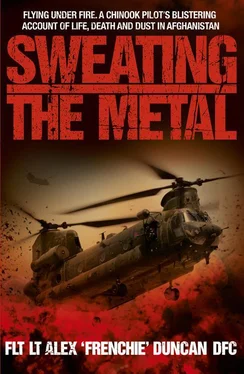There are three blades on each rotor, each one 3ft wide and 30ft long. At rest, they bow groundwards and there’s an air of tranquillity about them. When turning though, they spin at 225rpm – almost four times a second – and make no mistake: stray too close during the last stages of a shutdown and they’ll take your head off. The really stunning thing is that the blades on each disc intermesh – one blade will go then the other, then the other. They’re on the same level and they’re synchronised via a series of linked shafts that render it mechanically impossible for the blades to hit each other. It’s absolutely amazing when you think about it. The two discs rotate in opposite directions so the torque is cancelled out, which is why there’s no tail rotor. It also means you don’t use the pedals to counter the side-to-side movement (or ‘yaw’); they’re really only used in the hover – they turn the fuselage around a central axis.
The Chinook is massively flexible, so there are lots of options for control. The aircraft is fitted with three hooks – one with hydraulic release and two with electrical release – so the possibilities for picking up underslung loads are tripled: there are so many permutations. It has a maximum permitted take-off weight of over twenty-four tonnes, so it can carry a pretty hefty payload – including another Chinook.
You look at it and you’d imagine it handles like a Bedford truck, but it’s more like one of those crazy monster trucks that they use for the Paris–Dakar rally. It’s an exceptionally easy aircraft to fly – you almost think what you want it to do and it responds, so you only need the subtlest of touches on the control surfaces. Its incredible manoeuvrability and responsiveness belie its size, so you’d never think you have 60ft of cabin behind you; it feels like it stops right behind your arse. Its acceleration is phenomenal for a helicopter. It cruises at around 140 knots but you can squeeze up to 160 (185mph) out of it in certain conditions, although it’s incredibly noisy. Cleverly, those engineers at Boeing have carefully managed to design it so that most of the sound is in the cab rather than outside; that’s why we issue ear plugs to all our pax (passengers).
It can perform loads of manoeuvres that other helicopters just aren’t capable of, so it’s a dream machine to fly tactically. If you make an approach and have to turn into the wind, you can turn through 180° in around fifty metres – that’s about half the length of a football pitch, and you’re flying at around 120 knots. No other helicopter in the world can do that. You can use its bulk to assist you when stopping tactically – basically, fly in on the approach carrying a lot of speed, but scrub it off quickly by stepping the arse out as you flare, much the same way as skiers do parallel turns. You push the aircraft’s tail out one way and then turn it the other way.
In the same way that most modern cars need power-assisted steering and brakes, so the Chinook needs hydraulic assistance to power the flying controls. At sixteen tonnes even without any cargo, it’s a leviathan; one of the biggest helicopters in the world. To illustrate the importance of the hydraulic systems on the Chinook, there is built-in redundancy – two systems run in tandem in case one fails, and there’s a further back-up system in the unlikely event that both of them break, leak or otherwise fail. They’ve really thought of everything. It’s a truly brilliant aircraft.

The OCF is eight months long, and as with all the other flying courses, you spend a month at ground school followed by seven months of flying. Six hours was all it took for me to solo, which illustrates how second nature the flying side of things had become. Muscle memory kicks in, so it’s a bit like doing a car journey on a route you’re very familiar with, where you get home and can’t remember driving along a certain road. Almost the entire course is about learning to operate the aircraft and work as part of a four-man crew. In the cockpit, you and your co-pilot sit in armoured seats, with armoured panels and an armoured floor. In the back, you have two loadmasters, known colloquially as ‘crewmen’, and they are essentially responsible for running the aircraft.
Crewmen are vital to the craft’s operation. They’re responsible for the loading and unloading of pax and freight, for the attachment and safety of loads on the three hook points under the cab, as well as the safe restraint of all cargo. They are trained to navigate the aircraft when we’re under pressure up front, and to man the two, or sometimes three, weapons that comprise the Chinook’s armament: an M60 machine-gun on the ramp, and an M134 Minigun (also known as a ‘Crowd Pleaser’) on each door. The Minigun is an awesome piece of kit – it is mains operated and fires between 2,000 and 4,000 rounds of 7.62mm per minute from six rotating barrels. Direct Current versions have now been fitted to cabs in Afghanistan so that in the event of a crash-landing they can still fire by drawing power from the battery. These fire around 3,000 rounds a minute – that’s fifty 7.62mm rounds per second! Get hit by a burst and you’ll be pink mist.
It’s the crewmen’s job to talk the pilot down with height and distance calls, which they do by leaning out the door and the ramp so they have visual contact with the ground. This is particularly important at really dusty landing sites, like you’ll find in Afghanistan, where the dust cloud generated by the rotors’ downwash can completely obscure the pilots’ vision at the most crucial time of the descent. They’re also our eyes on any threats to the aircraft’s safety – be they obstacles, wires and cables, such as you’ll find across our green and pleasant land, or tracer fire, RPGs and small arms fire in a war zone. They’re able to refuel the aircraft, operate and man the winch, and they’re a key link between crew and passengers. In short, they are as important to the safe and efficient operation of the aircraft as the two pilots and it’s at the OCF where that really comes home. It’s the reason why so much of the course is devoted to working as part of a four-man (or woman) crew.
One of my colleagues on 18 (B) Flight was Hannah Brown, a great pilot and, very quickly, a close friend. We took an instant liking to one another. I thought she was great because there was none of this ‘lumpy-jumper syndrome’. She was straight down the line and never played on the fact that she’s a girl, like some others do. I respected her and, perhaps just as importantly, enjoyed her company – she was good fun.
At OCF you’re treated like an adult, and there’s a work-hard, play-hard mentality. You feel like a pilot there. When I was first strapped in to the Chinook, I was walking on water: at last I was a front line pilot and I could stick two fingers up to all those people who didn’t think I’d make it. Don’t get me wrong, it’s still not the end of the training, so you can’t relax. It’s just you’ve reached a point where your experience engenders a sense of self-belief.

It was towards the end of the course that I met Alison. Hannah and I had a night sortie as a two-ship and as I walked into the planning room for the Met brief, I saw this drop-dead gorgeous blonde girl. She was standing at the back, dressed in a nicely-fitted, stylish black dress, and I thought, ‘Fuck me, she’s fit!’ I did some asking around and discovered that her name was Alison and she was a guest of the Officer Commanding (OC). She was a senior civil servant at the Cabinet Office and they’d met on a counter-terrorism conference. The OC had invited her and a few colleagues along to the squadron for a flight. They were going to be Hannah’s pax.
Читать дальше













